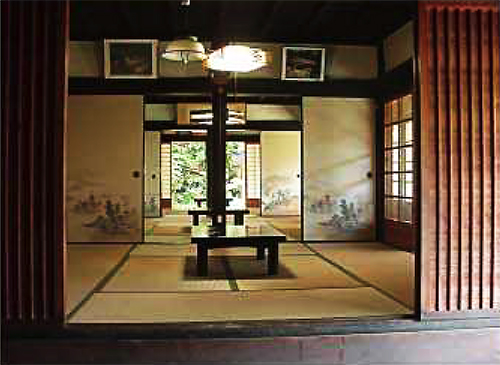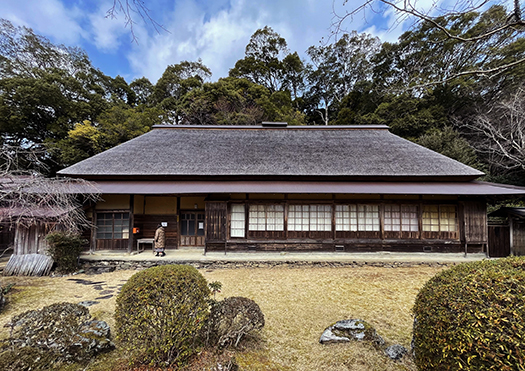


同姓ということで古民家探索人としては強い興味を持って参観した徳島・三木家住宅。わたしの血脈とは違うけれど「忌部氏」としての生き様に静かに打たれております。住宅取材というのは結局は「いい家」を探究することだと思っていますが、同時にリスペクトできる生き方というものが、ある種のスパイスになって空間性の美感を支配するということに感動させられる。
1枚目の写真は四国の中央部の山地での暮らしぶりの眺望。平成と令和の大嘗祭で麁服(あらたえ)の調進を果たした当主の三木信夫氏のインタビューが新聞記事アーカイブで確認できた。「麻を栽培する畑を整地し春に種をまく。何度も間引きをしながら約100日で成長した麻を収穫し、茎の天日干しから煮沸、皮を剥ぐなどの工程を経て麻の繊維を紡いでいき『麁服』が完成する。麁服にできる麻は気温が平地よりも3~5度低い高地といった限られた場所でしか栽培できない。この繊細な技術を確実に継承していくことは今後の課題だ」
この三木家住宅には古文書が伝承されていて、1260年鎌倉期の亀山天皇即位儀礼・大嘗祭での麁服の調進記録が残されているという。たぶんその時代から現在地で忌部氏・三木家一族は住み続けてきたのだろう。箱木千年家は兵庫県にある本当に千年以上経過の旧家だけれど、この家もまた同程度の歴史を見出しうる。代々の墓域での実体感からは、いわば家存続の強烈な、連綿たる意志力を感じさせられる。
住宅性能という革新を体験してきた北海道に暮らす現代日本人として、こういう種類の家の価値感というものにも深く打たれる思いがしていた。いわば人として生きる使命感、それを担保する地道な生き方の実践。そういう種類の家系的な価値感というものだろうか。
建築としての家には古格な雰囲気がただよっている。デザインはシンプルな端正さを保持し、機能性にまっとうに帰依した様子が伝わってくる。2枚目の内部写真は公開されているPDF資料からの転載。


家のデザインには独特の表現性があると思っている。安藤忠雄さんのように芸術者的な表現もあることは理解できるし、それを良しと考える施主の自由意志もあって然るべきだとも思っている。また地域の「らしさ」をしっかりと保持し永続させていこうと考える全国各地での草の根の街並み文化保存的なデザイン意思にも強い共感・好感を持つ。
この三木家住宅のデザインからは、シンプルな機能性がもたらす直接性、生き抜く意思が伝わってくる。四国とはいえこの山岳高地では冬に厳しい寒さもあるだろう。その厳しい条件下で家系の使命に真っ正直に生き抜いていくという心底を強く感じさせられた。こういう種類の「美感」には、強い尊崇の念を思う。
こういう家が高断熱高気密仕様で改修されさらに永い存続が可能になれば、次世代へのバトン受け継ぎに役立つのかも知れない。そんな願いがふと、こころをよぎった。
English version⬇
A way of life and residential construction that martyrs the family’s mission The Miki Family Residence in Tokushima, Japan – 4
This ancient house design conveys the strong will power of the clan. Perhaps it is the performance of the house that is appropriate for a way of life that perpetuates the family’s lineage. The house is designed to be a symbol of the family’s mission and the family’s strong willpower.
I visited the Miki Family Residence in Tokushima with great interest as an explorer of old private houses because we share the same family name. I was quietly struck by the way of life of the “Imobe clan,” even though it is different from my own bloodline. I believe that the coverage of housing is ultimately a search for “good houses,” but at the same time, I was moved by the fact that a way of life that I can respect becomes a kind of spice that dominates the sense of beauty of the space.
The first photo is a view of the way of life in the central mountainous region of Shikoku. An interview with Nobuo Miki, the head of the family, who performed the preparation of the clothing for the tamesai ceremonies in Heisei and 2022, can be found in the newspaper article archives. He said, “The fields where hemp is cultivated are cleared and the seeds are sown in the spring. The hemp stalks are then dried in the sun, boiled, and skinned before the hemp fibers are spun into “clothes. The hemp that can be used to make clothes can only be grown in limited areas, such as highlands where the temperature is 3 to 5 degrees lower than in the plains. It is our future task to ensure that this delicate technique is passed on to the next generation.
The Miki family’s residence has an old document that records the preparation of clothes for the ceremonial accession to the throne of Emperor Kameyama in 1260 during the Kamakura period (1185-1333), the first Emperor Kameyama’s death. Probably since that time, the Imobe and Miki families have continued to live in the present location. The Hakoki millennial family is truly a millennial family in Hyogo Prefecture, but this family can also be traced back to the same period. The sense of substance in the graveyard of generations of the family gives one a sense of the strong, unbroken willpower of the family to continue its existence.
As a modern Japanese living in Hokkaido, which has experienced innovations in housing performance, I was deeply moved by the sense of value of this kind of house. A sense of mission to live as a human being, so to speak, and the practice of a steady way of life to ensure it. This kind of family values, I suppose. The house as an architectural structure has an old-fashioned atmosphere. The third interior photo is a reproduction from a publicly available PDF document.
I believe that house design has a unique expressiveness. I understand that there is an artistic expression, such as that of Tadao Ando, and I also believe that there should be the free will of the client who thinks it is a good idea. I also have a strong sympathy and liking for the grass-roots design intent to preserve and perpetuate the “character” of the local community.
The design intent of the Miki family residence conveys the directness of simple functionality and the will to survive. Even though it is in Shikoku, there must be severe cold in winter in this mountainous highland. I was strongly impressed by the family’s heartfelt determination to live out their family’s mission honestly under such severe conditions. I have a strong sense of reverence for this kind of “sense of beauty. If such a house could be renovated to “highly insulated and airtight” specifications to ensure its longevity, it might be useful in passing the baton to the next generation. Such a wish suddenly crossed my mind.
Posted on 1月 28th, 2023 by 三木 奎吾
Filed under: 住宅マーケティング, 日本社会・文化研究







コメントを投稿
「※誹謗中傷や、悪意のある書き込み、営利目的などのコメントを防ぐために、投稿された全てのコメントは一時的に保留されますのでご了承ください。」
You must be logged in to post a comment.